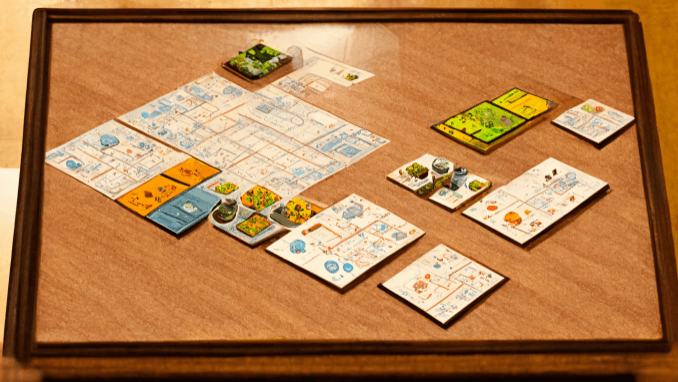
Simulations have a long and distinguished history in games-based learning, and their use predates the term by decades, and probably centuries, depending on what one considers as ‘games’.
The earliest simulations with a focus on learning and improvement were wargames, and it could be argued that modern learning simulations, or even games-based learning as a field, has grown out the need for combatants to understand past strategies, and to develop and test new ones.
The term ‘simulation’ is also used to describe a subset of learning tools which enable ‘learning through doing’ in the sense of practising skills – including flight simulators, patient simulators, and the like. These will not be considered in this article, mainly because realism, which is considered below, is a requirement for these tools, not a question for consideration.
What is a Simulation?
In the context of learning games, a simulation is designed to replicate situations that occur in real life for the purposes of analysis, planning or experimenting with options. Common examples include business simulations, resource management simulations and role-playing.
An air of respectability
Given the definition above, it could be argued that games incorporating role-play or games that have a ‘real-life’ theme, could be called ‘simulation’. Indeed, in the earlier days of games-based learning, it was a common strategy to call a game a ‘simulation’ to mitigate any potential objection from clients about games being ‘childish’ or trivial, or not being appropriate in a professional learning setting.
‘Simulation’, it was believed, had an air of respectability, that ‘game’ did not. Something that was actually little more than a marketing strategy has coloured how games for learning are not only seen, but also how they are designed, to this day. Where other types of games are used, but are called ‘simulations’, this only muddies the waters about how games work as an effective pedagogy, about the mechanisms that are actually in play, and how they link to the construction of knowledge by learners.
It also means that simulations become a ‘preferred’ genre where other game or play experiences might be more appropriate in a specific learning setting or in the context of particular desired outcomes.

The Benefits of Simulation-based learning…
In some situations, of course, a simulation is the best solution to a learning challenge. Some of the best-known benefits of games-based experiential learning include:
- Trying and failing safely
- Compressing time in the decision – action – outcome cycle
- Encountering situations that are unusual in real-life
- Cost (and time) effective exposure to situations that are infrequent or hard to organise in real life
And these are all aspects in which simulations perform particularly well.
If the learning you are trying to facilitate is congruent with the above, then a simulation may very well be the way to go. So, what should be included in your design to ensure that your learners can take full advantage?
Failure is a great teacher, and the conditions can be optimised for learning by providing timely and comprehensive feedback on in-game decisions and actions. One really effective way to learn from failure is to be able to try again, and experiment with new decisions and actions. The greatest flexibility for learners is facilitated where the game allows a total ‘wind-back’ to the starting position, as well as the capability to build on previous round on round decisions.
There should be a balance between complexity (and realism) and the time required to create meaningful experiences through the game. It is not necessary that all situations encountered in the game should be modelled with the same degree of realism. Those with mostly thematic value can be simplified to allow extra time for those which are actually the focus of the learning outcomes. For example, a game designed to create learning on making decisions with limited information uses financial results as a measure of ‘success’, but should not necessarily require the players/learners to dwell on ‘real’ financial documents (Profit and loss, balance sheet), unless reading and interpreting financial documents is actually a focus of the learning.
Be clear on what situations need to be simulated in your game and what do not, and be informed in that by direct reference to learning outcomes. A modular design which allows for the inclusion and exclusion of different simulated aspects, or which allows the use of different scenarios with a vanilla ‘engine’ is the ideal way to create a product which can be widely implemented with a variety of learning settings and outcomes. This is also, potentially, the most cost effective model for both learning provider and client.
…and the Drawbacks
Compared to other types of game experiences, simulations can be expensive. Even a simple representation of ‘reality’ requires several parameters and with each added parameter the complexity of interactions between all the moving parts increases exponentially. For example, if we were to simulate a predator/prey interaction (e.g. fox and rabbits), modelling the rate of (rabbit) population would decline over a single generation, requires only starting population of both species and a predation rate. Even very simple realism, requires that you add some sort of ‘fox starvation’ mechanism, and adding more generations needs birth and (non-predation) death rates of both species. Our model still only assumes that foxes need a food source, and so we then need to implement grass… and so on. All this complexity eats up design and development time.
Pushback on realism and ‘correctness’
Simulations, wherever they sit on the continuum between simple and complex (or abstraction and realism) do intend to replicate some aspects of real life. This incurs a risk in relation to the perception of learners. If a learner is very familiar with the simulated situations and they perceive them to be ‘lacking’ in some way, either because they are not ‘accurate’ enough or that they lack proper detail, this may have an adverse impact on how receptive they are to the outcomes from the simulation, and any learning they might derive.

Complexity
As the rabbit/fox example illustrates designing for learning through a simulation can get very complex, very quickly, and depending on your desired outcome, that can include designing in complexity (with its associated overhead) that is not actually needed to meet your outcomes. Thematic authenticity can do this. For example, a simulation which is supposed to support outcomes around dealing with a VUCA world uses ‘running a utilities business’ as a thematic setting, and requires that aspects of that theme are simulated, even when learners have no need to learn anything about that.
Hard to isolate from wider context
A related problem, which may actually be the cause for unneeded complexity is the difficulty in isolating the required learning experiences from wider context when you are using simulation as the medium. Generally speaking, the more call that there is for demonstrating and practising context specific skills and behaviours during a learning programme, the more likely it is that a relatively authentic simulation would be suitable.
As an example, if a specific learning programme focused on leadership competencies, within the context of a retail environment, it would make sense to simulate much of the retail environment, because learning would be achieved by enacting relevant behaviours. If, instead, the focus was on leadership mindset (learning in the affective domain rather than skills domain), context would be less important, as it would also be if the focus was on generally applicable, rather than context specific, competencies.
The Case for Realism
The decision to use a simulation to support a particular set of learning outcomes implies that there is some advantage to be had, in including some level of ‘realism’ in the experience. If that is not there, it might be wise to reconsider why you should use a simulation over some other form of game.
The questions to ask would be:
- Is there advantage in situating the learning in a specific context (type of business, set of specific activities)?
- Are there aspects of the real setting that can be excluded while still satisfying the learning requirement?
- Can the resultant experience be made sufficiently ‘accurate’ that it will not distract/alienate learners?
The Case for Abstraction
Abstraction – removing specificity, or even setting the simulation in a completely non-realistic setting can be helpful in many circumstances:
- It can be a cheaper option to reduce specificity because it reduces the overhead of complexity.
- It is hard for learners to be distracted / alienated by ‘lack of accuracy’ if the simulation is set in a fictional Martian colony, for example.
- Less specific, abstracted simulations can be suited to a much broader set of learning applications.
Simulations provide us with a useful set of tools for modelling behaviours, practising skills and experimenting with scenarios, but they are by no means the only option, and we should be cautious of relying on the ‘respectability’ of the genre, when in many cases, simpler, cheaper and more generic solutions can provide us with outcomes which are just as effective.
- James Bore – The Ransomeware Game - 13th February 2024
- Ipsodeckso – Risky Business - 23rd January 2024
- Review – Luma World Games - 15th December 2023





What you wrote about training ai.ed at teaching within the affective domain really resonated with me. I had never thought of the limits of simulations in that context.
Thanks Linda. Maybe we can discuss further at our next meeting.